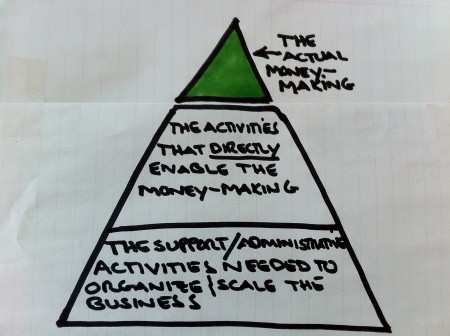57 Meditations on Kicking @$$ in Business and Life"4.8/5 stars" on Amazon
7 Easy Ways to Tackle Your To-Do List
Tweet CommentI write a to-do list at the start of just about every day, but it can be tedious so I look for ways to shake up the process. Here are some ideas I find useful (in no particular order):
1) ABC Method — Try the ABC Method in which you write down the tasks you need to do and categorize them by:
- A = Critical to your goals and must be done that day.
- B = These are less urgent but should be started after your A’s are done.
- C = These are nice-to-do tasks that can be done if you’ve got some extra time
2) The 1-to-10 Stress Method
- List down all the to-dos that are stressing you out at the moment
- Rank them 1 to 10 in which 10 is stressing you out the most and 1 the least
- Tackle the tasks ranked 10 first, 9 next, 8 after that, etc.
3) Andreessen’s 3 to 5 Things on an Index Card — Marc Andreessen found it valuable to write down 3 to 5 things that you want to get done the following day. He does the following:
- The night before he writes the 3 to 5 most things he wants to get done on an index card
- He wakes up and tries to do those things
- For anything else he does (not on the list), he writes those things down on the opposite side of the index card and calls them his “anti-to-do” list.
No comments yet | Continue Reading »
Saturday, September 10th, 2011
How I Use This Nerdy “Money-Making Pyramid” To Prioritize Business Activities
Tweet 1 CommentAre you leading a business, new or old?
I’ve done both: I’ve started businesses from scratch and I’ve also taken over leading a business that was already a few years into the game.
Either way, the difference between success and failure is what you and your team are working on…and when!
Caution: If you entrepreneurs out there don’t grasp this, your business is very likely to fail (especially my friend who’s spending a couple of hours a week figuring out Quickbooks instead of focusing on making money!).
My marketing-guru friend and previous business partner Eben Pagan inspired the money-making pyramid (he called it the “productivity pyramid” in his awesome GetAltitude “Top Gun For Entrepreneurs” program — it’s a neat visual using a pyramid to illustrate what’s most important to work on in a business.
I’ve riffed a bit so blame me (not Eben) if you don’t like my “Money-Making Pyramid” version.

The money-making pyramid illustrates that the money-making in your business belongs at the top (most important) with the items below it less important the lower down on the pyramid.
1 comment so far | Continue Reading »
Sunday, December 12th, 2010
5 Easy Tips On How To Be Successfully Prepared (From An NFL Coach)
Tweet 3 Comments[My new friend Umberto Leone was an Assistant Coach in the NFL for the Cleveland Browns and Oakland Raiders; he wrote the article on preparation below (with some editing for space by me).]
As U.S. President Abe Lincoln once said about the importance of being prepared:
“If I had 6 hours to chop down a tree, I’d spend 4 hours sharpening my axe.”

Coach Leone corralling the Cleveland Browns
As a former Assistant Coach in the National Football League for five seasons, as well as three years assisting on the collegiate level, my work-life revolved around preparation.
I learned some valuable tips & pointers on preparedness and look forward to sharing them with you.
Preparation Tip #1: Teamwork
You hear the word “teamwork” thrown around the sports world all the time. Many athletes thank their teammates for the individual awards they receive.
Not only is teamwork a requirement on the field of play, within the preparation process teamwork is crucial.
As a coaching staff, each of the preparation duties is shared amongst the entire staff.
For example, one coach may be responsible for the 1st and 2nd down game plan while another coach’s responsibility is 3rd down and 2 minute.
Another coach may have the Red Area and Goal Line situations.
You must rely on the successful work of each individual coach in order for the whole coaching staff to be properly prepared.
Teamwork Preparation Questions For You:
- Do you efficiently spread responsibilities among your team?
Do they have assignments as specific as who’s responsible for 1st down decisions or what you do when you’re close to the “Goal Line?
Preparation Tip #2: Ask Yourself the “What If” Questions
To properly prepare you have to be able to ask and answer the appropriate “what if” questions; this helps you increase and broaden your mindset.
An increased and broadened mind allows you to think about a variety of possibilities and how to prepare for them all.

Coach Leone (on right) talks things over with Coach Mel Tucker
In football terms, some examples of the “what if” questions we asked ourselves each week to help us prepare:
- “What if they start using a no huddle offense”?
- “What if they fake a field goal or punt”?
- “What if they give us a trick play “?
- “What if they bring a blitz that we have never seen before”?
- “What if its 4th and 1 and they go for it”?
- “What if its 4th and 5, we are losing by 3 points with the ball at the 35 yard line, 45 seconds left in the game and we have no timeouts left – do we kick a field goal or go for the first down”?
- “What if our QB gets hurt”?
When you ask yourself the appropriate “what if” questions, it will deepen and broaden your mind and thus drastically improve your preparation level.
What-If Preparation Questions For Your Team:
- Does your team discuss “What-If” contingency plans?
- Are you prepared in the event a key person on your team resigns?
- Are you prepared for your largest customer or partner leaving you?
Preparation Tip #3: Role-Play
In football it was vital for us to think as our opponent would think.
We’d study ourselves in a way that the opponent would: understanding our weaknesses, knowing the areas that they would attack, and being able to prepare accordingly.

Brandon McDonald runs at Coach Umberto
For example, we prepared for the following game by studying our opponent on film (and over time collecting a huge database of their plays).
During practice our Scout team would utilize those plays and run them against our own team.
At times we would run the play a little differently – attacking the weak area of our team in a way that would make the opponent’s play more successful.
For example, if we are playing the Eagles, our scout team wouldn’t have a slow non-athletic QB: we’d put the closest version to Michael Vick we had on our team to better role play that position.
Role-Play Preparation Questions For You:
- Do you have a database of plays you and your competition rely on?
- Do you ever role-play any scenarios in your business?
- If you have to have to fire someone, do you use a colleague to role-play the script with them beforehand?
- If you are giving an important speech, have you ever tried practicing it aloud to another person whose opinion you trust?
Preparation Tip #4: Research & Study Hard
Though we only played one game every week, the amount of preparation that went into every game was astounding.
From the Sunday evening following the afternoon game, to the Saturday night team meal and sometimes even until the Sunday morning breakfast, we were preparing.
Legendary coach Joe Paterno once said
“The will to win is important, but the will to prepare is vital”. As NFL Coaches, we all definitely have that will.
Without doing the research, your mind is not prepared to ask the appropriate “what if” questions. Your mind is no shape able to role-play either.
Imagine being a football coach and never having seen the opposing team play a game. You would have no idea what plays they like to do, what strengths and weaknesses they have as a team, etc.
Research/Study Hard Preparation Question For You:
- Are you researching & studying your goals comprehensively enough that you have identified the major “What-If” and Role-Playing scenarios you could face?
Preparation Tip #5: Practice and Review
In preparation, once you are satisfied with your thought process — ideally by completing preparation tips 1 through 4 above — you need to practice your plan…through action!
Learning by actions allows you to experience things you originally didn’t think about.
As a football coach, the daily practices we had were crucial to the team being prepared for each week’s game. In addition to the role-playing practices mentioned above, we did individual position drills.
Each position worked on individual drills pertaining to their position:
- Lineman worked on blocking fundamentals;
- Defensive backs worked on covering fundamentals;
- And wide receivers worked on route running.
And if we knew that the other team posed a problem for us on any of the fundamental levels we made sure we worked that fundamental area more intensely.
For example if they had small – quick wide receivers our DB’s worked more on foot quickness drills.
Practicing at different speeds was also important:
- We started practice with a walk-through in which we did at half speed the plays we were going to work the day in practice.
- Then we went to the individual/fundamentals part of practice so that we could run the plays successfully.
- Then we ran the plays at full-speed in a competitive fashion.
Practice & Review Preparation Questions For You:
- Do you practice your skills & timing before YOUR big game/event?
- Do you identify the fundamentals that you’re weakest on and prioritize those?
- Do you take your sales & marketing “plays” and practice those at a slower pace to make sure you can nail them when it’s “game-time”?
Successful End Results
Our expectation was to be prepared enough that no matter what happened during the course of the game, we were able to handle it in a successful fashion.

Anything the opposing team did, from the most usual to the most extreme, our team was prepared enough that they could face it all and still be successful.
I believe these preparation tips I learned from the NFL could be used to help you with anything from preparing for a job interview to preparing a business plan to preparing for an exam.
The key is to get prepared for whatever key challenge you face.
A Recap Of My 5 Tips To Successful Preparation
- Teamwork — Organize and utilize your available resources. Be proficient and efficient.
- What-If Questions — Increase and broaden your mindset. Evaluate rational scenarios.
- Role Play — Put yourself on the other team. Think as they think and prepare yourself accordingly.
- Research and Study Hard — The foundation for your preparation.
- Practice and Review — Learn by your actions before the real event takes place.
Following these 5 guidelines will go a long way to helping you achieve number 6 in this article – Successful End Results!
If you want to get in touch with Umberto Leone he asks that you do so through his LinkedIn profile.
3 comments so far (is that a lot?) | Continue Reading »
Sunday, July 25th, 2010
5 Steps To Inevitability Thinking (E.g. How To Make It Inevitable That You’ll Generate $20K Per Mo. In Ad Revs)
Tweet 3 CommentsI remember when my friend Eben Pagan shared the concept of Inevitability Thinking with me — it’s such a simple yet powerful approach to achieving your objective…damn, why didn’t I think of that!?

Victoria the Roman Godess of Victory on Wellington Arch
The easiest way for me to share Inevitability Thinking is to give an example (I’m going to use a hypothetical example of an Internet business I want to build).
To do this exercise on your own you would need:
- A Calculator
- Your Brain
- A half-hour or so of time
But, if you want, you can just read my version of this exercise first.
Ok, so here are the steps:
5 Steps To Invetability Thinking
1) Articulate Your Objective
First step is to articulate your objective.
For this exercise, let’s assume your objective is to build a content-based Web site that generates $20,000 per month in advertising revenue.
Sound good?
2) Identify Your Time Frame?
Easy next step: let’s pick a time period to meet your objective of $20,000 in ad revenue per month.
We all want to reach our goals immediately…but let’s be realistic: how does one year sound?
After all, most things that matter in life take time.
One year it is!
3) List Your Inevitability Levers To Achieving Your Objective
Ok, this is still super-easy.
Now you just identify what levers to pull to make it imperative to achieving your objective.
I call these inevitability levers because they are imperative to your objective.
Let’s start at the very top-line of levers you’ll be working with.
For example, to build a content-based Web site that generates ad revenue, you’re gonna need at least these two levers:
A) Advertisements (that are sold)
B) Content (that’s on your Web site)
Note: down below we’ll drill down deeper into a few mini- levers within these inevitability levers.
4) Make Realistic/Conservative Assumptions Quantifying Your Inevitability Levers
You do have to get your hands a little dirty on this one.
Next up, you’re going to start to make assumptions about your inevitability levers.
The key tip about your assumptions is to make them realistic/conservative: afterall, we’re trying to make it inevitable that you’ll achieve your objectives (don’t be overly optimistic).
Let’s start with your advertisements
Assumptions on Selling Advertisements
Advertising revenue is a pretty simple formula: you’ve got to price your ads and you’ve gotta sell your ads.
Let’s start with ad pricing: what’s a conservative assumption we can use on how much you can make from an online advertisement?
Shh, here’s a secret tip on how to track that down: go to a site called “Google.com.”
I searched “average CPM (CPM stands for cost per thousand impressions) of an online ad” and I found that $2.43 is a good average CPM for the Internet as a whole, according to Comscore.
note: I also found a cool graph in this Adify Report that showed CPMs for different vertical markets such as Automotive, Beauty/Fashion, Business, Moms and Parents, Sports, Technology, Travel, Real Estate, Healthy Living/Lifestyle, News and Food (the CPMs in this graph were much higher (average of $7.71 but you want your objectives to be inevitable so lets be conservative and use the $2.43 figure instead).
Ok, let’s use the average CPM of $2.43; if we use that, then that means you’ll generate $2.43 for every 1,000 impressions (aka page views) of your Web site.
To keep things simple, let’s assume that you’re just selling one ad on every page of your Web site.
5) Start Asking Inevitability Questions
Now we need to figure out how much volume of ads you need to sell (since we’re selling one ad per page, we can just call what we’re looking for: “page views” (i.e. each time someone views a page of your content, one ad is served).
Now, bust out your calculator: you want $20,000 per month so you’re going to have to do the following calculation to figure out what would make it inevitable to get enough page views to generate twenty grand:
20,000 ÷ by ($2.43/1000) =
8,230,452 page views that you would need to generate $20,000 in ad revenue.
Ok, now you have to do the same exercise with 8.23M page views:
What would make it inevitable that you would generate 8.23M page views?
The answer: a certain number of “visits” to your Web site. On the Internet, a page view is generated by a visitor visiting your site and looking at a certain number of pages.
Ok, back to assumptions (and don’t forget to be conservative about your assumptions…after all, we’re trying to make it inevitable that you’ll achieve your objective!).
And don’t put your calculator away just yet either!
Visitor Assumptions
So we need to use another assumption for how many pages a visitor would view to continue our math.
You can go Google your particular vertical, but let’s keep things simple and assume that a conservative estimate is that an average visitor will view 5 pages each time they visit your site.
Calculator-time again:
So, if you want it to be inevitable to generate 8.23M page views, then you would need to do this calculation:
8.23M ÷ 5 = 1,646,000 visits
So, if you had 1.65M visits it would be inevitable that you would generate 8.23M page views and thus $20,000 in ad revenue (using your conservative assumptions of course!).
Ok, so now you might ask:
How the heck am I gonna get 1.65M visitors to my Web site (in a month!)!?
Well, you’re probably already thinking of a few different ways such as:
- Buying Ads
- Appearing on Oprah
- Getting Sites to Link to You
- etc.
All are good approaches and you could apply inevitability thinking to any of them…but let’s keep it simple.
Let’s say you believe that your Web site’s content can help you attract traffic (remember, content is your other core lever!).
Content Assumptions
Ok, so how much content would you need to make it inevitable that you would attract 1.65M visitors per month?
Ok, you’re gonna have to make some more assumptions…this time around content.
Here’s where I use my trusty SEOBook tool (see How To Have X-Ray Vision About Your Competition) which will tell me both:
- Number of Visitors To Different Sites
- Number of Pages of Content (at least according to Google & Yahoo whose job it is to index pages on the Web)
Let’s say that you find that on average your competition generates 100 visitors per month for each page of content that they have (by the way, an example of one page of content would be this article you’re reading right now).
Calculator-time again!
So, if you want it to be inevitable that you’ll receive 1.65M visits in a month through content then you’d do the following calculation:
1.65M ÷ 100 = 165,000 pages of content that you would need
Ok, I know, it sounds like a lot of content.
But, remember, this is one year from now.
And, actually, there are tons of Web sites who generate hundreds of thousands of pages of content with little cost (beyond engineering time and hosting cost).
They get their voluminous content from users (aka “user-generated content”) and many of them do it merely by providing a quality bulletin board or question and answer service.
Check out StackOverflow, for example:
SEOBook tells me they have 8 million pages indexed by Google (note: they were founded in 2000 so they’ve been doing this for 10 years)…and they provide this primarily through offering a Q&A service for engineers.
StackOverFlow claims more than 1M visitors every month…now we’re talking!
Ok, so now what would make it inevitable that you generated 165,000 pages of content?
Well, let’s assume for the moment that you’re going to do a blog instead to generate your content.
Conservation Assumptions Again:
Let’s assume that you can write 3 blog entries a day or about 1,000 per year (I’m giving you a couple of weeks of vacation time!)…well, to get to 165,000 pages of content that would take you 165 years!
The oldest living man right now is only 114 so let’s go to plan B.
Well, there are actually free multi-user blogging platforms that allow you to let others blog beyond just you!
So, let’s assume that you can get other writers like you to post 3 blog entries per day (around 1,000 per year with a few vacation days for them too (you’re no slave-driver!).
So, to get 165,000 pages of content through multi-user blogging then you would need:
165,000 ÷ 1,000 = 165 Blog Writers
Ok, so now what would make it inevitable that you could sign up 165 Blog Writers.
Perhaps you have a bunch of Facebook friends or alumni or colleagues who you could talk into helping you blog. But that would be tough for most people so let’s
Did I Mention You’ll Have To Google A Few Things In This Exercise?
Let’s look around for a writers group…Googling “writers group” gives me WriterMag, a magazine with more than 30,000 writers.
Ok, so what would it take for you to convince 160 of those 30,000 writers (.533% of them) to write for your blog (many writers might do it for free just for publicity!).
Let’s assume that you talked to WriterMag’s ad sales team and they told you that they were super-confident that if you ran a full-page black and white ad in their magazine — offering their 30,000 readers free publicity on your blog — every month for six months that it would be inevitable that you would get your 160 bloggers.
Well, such an ad looks like it would cost about $10,000 according to the rate card on their Web site (you can often get discounts to “rate card” and my guess is that you’d get at least 25% off for a 6-month commitment (times are tough for the publishing industry!).
So, a commitment by you of $7,500 should get you the 6 months of full-page ads.
Ok, we’re wrapping it up now.
The gist of this invetability thinking exercise is that:
- If you bought $7,500 worth of ads you could get
- 160 bloggers to create…
- 160,000 pages of content that would generate…
- 1.65M visits per month, which would produce…
- 8.23M page views per month, which could be sold for
- $2.43 CPM, which would make you
- $20,000 per month in advertising sales…
- in one year’s time
This is of course a simplified version of how you’d really conquer your objective (the devil will be in the details and you’re going to have to do your homework on levers, assumptions and the approaches you use).
But the point is: if your levers and assumptions are roughly correct, you will roughly achieve your objective through this approach.
I hope you found this inevitability thinking exercise useful.
Thanks, Eben!
3 comments so far (is that a lot?) | Continue Reading »
Thursday, July 1st, 2010
Remote Workers: Check Out Your New Virtual Colleague!
Tweet 7 CommentsHere’s a cool robot that can cruise around your home or office with a 5 mega-pixel HD camera with zoom due out this Fall from AnyBots.
Not bad for $15,000.
Applications/Features?
- If you work from home, this robot can cruise to your front door and show you who’s ringing your bell
- This robot can be your eyes and ears at another location (while you stay put)
Check out these videos.
This one is a corporate video from AnyBots.com (but it shows the robot in action):
Here’s an example of AnyBot checking out a White Board session (so that you don’t have to be there to collaborate):
Here’s a separate story on AnyBots from Network World:
7 comments so far (is that a lot?) | Continue Reading »
Saturday, January 9th, 2010
SWOT Analysis Examples: Google, Coke, Walmart & More
Tweet 15 CommentsA bunch of people checked out my article on SWOT Analysis and asked me for more examples of this powerful strategic planning tool.
It turns out that it’s not easy to find free SWOT Analysis examples (many are listed on the Web but cost money (anywhere from $10 to $500 apiece!).
I found over a dozen examples of SWOT that are free to review…and listed them below.
Enjoy!
SWOT Analysis Examples
- PepsiCo
- Walmart
- Microsoft
- Oracle
- Dell
- McDonald’s Corp.
- Starbucks
- Sun Microsystems
- Pizza Hut
- Walt Disney
- The Cosmetics Industry
- Handspring
- Video of SWOT Analysis (woman showing it on a whiteboard)
- Video Example of How to Do a SWOT Analysis using MS Word and Excel
- SWOT Example of a Web Site
- SWOT Example of a Coffee Shop
- Personal SWOT Example for Carol, an Advertising Manager
- SWOT Example of the State of Minnesota Department of Employee Relations
- Coca Cola (this link had some issues one time I checked)
- Mobitel (Exhibit 34, page 33 of this report)
If you know of any other SWOT Analysis examples, please let me know by just linking to them in the Comments field below — thanks!
15 comments so far (is that a lot?) | Continue Reading »
Monday, November 9th, 2009
Put Your Eggs In One Basket
Tweet CommentYou can put all your eggs in one basket (just watch the basket!)
We’ve all heard the saying that you shouldn’t put all your eggs in one basket. While sometimes wise, I think there are many exceptions.
Mark Twain wrote that you should “put all your eggs in one basket and watch that basket.” I agree in many circumstances, including for business.
If you are super-selective and focus on one business (whether as investor or founder or employee) at a time, you can reap huge rewards. Look at Bill Gates of Microsoft (who loves using the word “super” by the way) — he invested purely in Microsoft for 30 years.
I had the good fortune of meeting Bill Gates a few times and I recall how reporters and other people were highly critical of the fact that he was reinvesting his Microsoft profits in Microsoft and not, for instance, in Philanthropic endeavors.
He told me that he believed his most valuable contribution at that time was focusing on Microsoft and that he would later focus on investing his money elsewhere.
Well, in 2000 Bill and his wife Melinda French (who I also had the pleasure of meeting once) created what is now the largest charitable foundation in the world and Bill turned his focus to investing in creating value elsewhere (specifically, helping solve many of life’s diseases).
So, Bill had his Microsoft basket for 30 years and now has his Foundation basket.
Similarly, Warren Buffett, who has created more wealth investing than anyone to date, has focused primarily on one business — Berkshire Hathaway — most of his life.
If the stock in Berkshire were to tank, Warren’s net worth too. But it probably won’t, because Warren is watching his one basket!
It’s no coincidence that when Warren finally decided to put his eggs (his money!) in a second basket, he chose to put them in the Bill and Melinda Gates Foundation basket – one that he trusted would be watched closely for years to come by his younger friends Bill and Melinda.!
No comments yet | Continue Reading »
Sunday, November 8th, 2009
5 Simple Steps On How To Do A Gap Analysis
Tweet 17 CommentsGap Analysis is a strategic planning tool to help you understand where you are, where you want to be and how you’re going to get there.
Here’s a simple Gap analysis chart:

Here's an example of a GAP analysis for profit
Here’s the Gap Analysis process:
Step 1: Decide the topic you’re going to do the Gap Analysis on? This is the challenge you’re trying to tackle.
Gap Analysis sample topics include:
- Revenue
- Profit
- Market Share
- Product Functionality/Features
Step 2: Identify where you are right now based on metrics or attributes.
Examples:
- Revenue — We’re at $10 million in annual sales right now
- Profit — We’re at $1.5 million in annual profit right now
- Market Share — We have 7% of the market share right now
- Product Functionality/Features — Our product has was just launched so it has limited features
Step 3: Identify where you’d like to be over a specific time frame?
Examples:
- Revenue — We’d like revenue to grow to $35 million in annual sales by 2012
- Profit — We’d like profits to grow to $12 million per year by 2012
- Market Share — We’d like to own 15% of a particular market by 2012
- Product Functionality/Features — We’d like our product to have industry leading features by 2012
Step 4: Identify the gap between where you are and where you want to be.
- Revenue — They gap is $15 million per year in annual sales by 2012
- Profit — The gap is $5.5 million in annual profit by 2012
- Market share — The gap is 8% market share by 2012
- Product Functionality/Features (let’s use Web site as an example) — The gap is that you’d like to have the following features by 2012: a blog, a sign-up form to let visitors follow your business on Facebook and Twitter and a way for customers to buy products directly.
Step 5: Determine how the Gap should be filled.
- I recommend using the “6 M’s” from my Fishbone Analysis Article:
- Manpower — The people resources you need.
- Methods — The processes you need.
- Metrics — The measurements you need.
- Machines — The automation or technology you need.
- Materials — The material items (such as physical goods or marketing collateral) you need.
- Minutes— The time you need.
- Or you could use a SWOT Analysis and simply list out your:
- Strengths, Weakness, Opportunities and Threats related to filling your Gap.
Some other related Gap Analysis definitions:
- Usage Gap = Market Potential minus Existing Usage
- Product Gap = The part of the market that your missing because of your product features.
Fore more on the Gap Analysis model, check out Gap Analysis Wiki.
Note: There’s a separate “GAP” used in business related to how to run meetings. Read The 3 Simple Steps To An Effective Meeting: The GAP Approach for more.
